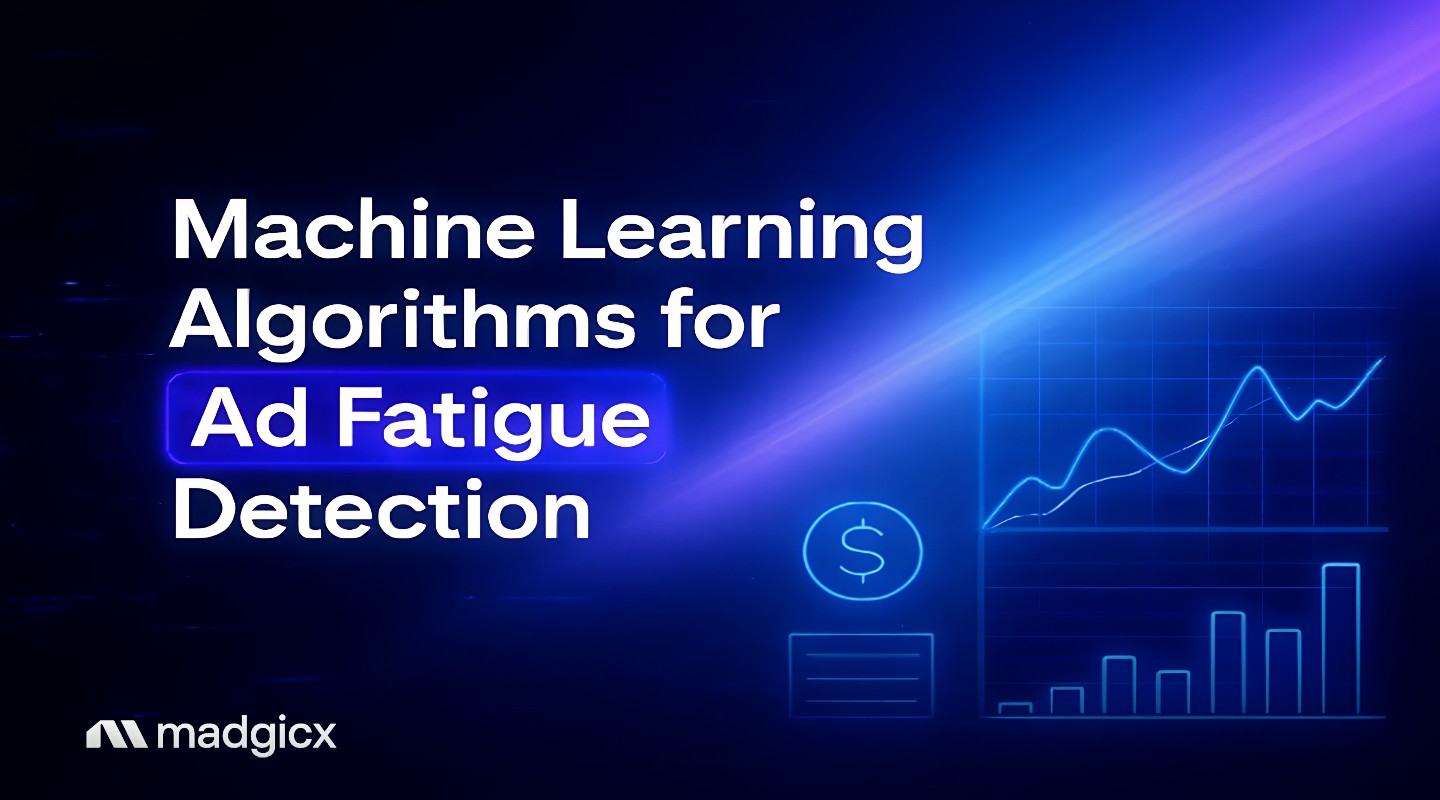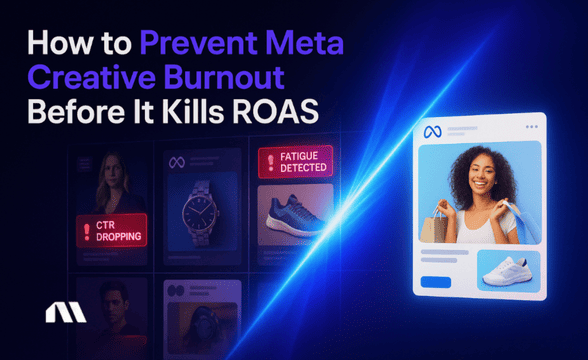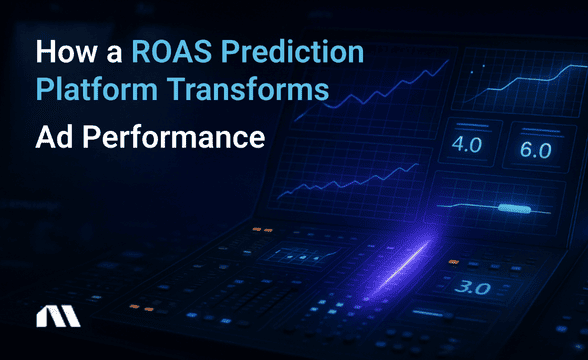Learn machine learning algorithms for ad fatigue detection with accuracy. Complete guide with SVM, neural networks, and real-time optimization strategies.
Picture this: You're managing a high-performing campaign that's been crushing it for weeks. CTR is strong, CPA is on target, and then suddenly—like a switch flipped—performance tanks.
Your audience has hit ad fatigue, and by the time you notice, you've already burned through budget on declining returns.
This scenario plays out thousands of times daily across advertising platforms, but what if you could predict it a week in advance? Machine learning algorithms for ad fatigue detection are sophisticated systems that analyze user engagement patterns, creative performance metrics, and behavioral data to identify when ad effectiveness will decline.
These systems are designed to achieve 90-97% accuracy in predicting when creative refresh is needed when properly implemented and trained on sufficient data.
The challenge isn't whether these algorithms work—it's knowing which one fits your specific use case and how to implement them effectively within your existing advertising workflow. According to recent industry data, 76% of consumers cite ad fatigue as their biggest engagement hurdle, making this one of the most critical optimization challenges we're all facing as performance marketers.
What You'll Learn
- Algorithm Performance Comparison: SVM vs Neural Networks vs Ensemble Methods with real accuracy benchmarks (designed for 90-97% range in testing environments)
- Implementation Framework: Step-by-step deployment guide for integrating ML detection into your advertising workflow
- Platform Integration: How to connect fatigue detection algorithms with Meta, Google, and other advertising platforms
- Performance Optimization: Advanced techniques for real-time processing and AI-assisted creative refresh systems
- Bonus: Cost-benefit analysis showing potential for 15-35% campaign efficiency improvements with proper implementation
Understanding Ad Fatigue Through Machine Learning Lens
Here's the thing about ad fatigue—it's not just declining performance, it's a predictable pattern that machine learning excels at identifying. When consumers see the same creative repeatedly, their engagement follows measurable decay curves that algorithms can model with remarkable precision.
Machine learning algorithms for ad fatigue detection involve training systems to recognize patterns in user engagement data that indicate declining creative effectiveness. This typically occurs after 7-8 ad exposures per user. These systems analyze multiple data points simultaneously: click-through rates, conversion patterns, user interaction depth, and temporal engagement trends.
The beauty of ML approaches lies in their ability to spot subtle pattern changes that we humans miss. While we might notice a 20% CTR drop after it happens, machine learning systems can identify the early warning signs.
These include micro-changes in engagement velocity, slight shifts in user behavior patterns, or emerging negative feedback signals that predict major performance decline.
The Data Behind the Problem
Research shows that CTR declines by 15% within the first week of campaign launch as audiences become familiar with creative content. Even more concerning, studies indicate a 40% decline in click-through rates with excessive frequency exposure.
This makes proactive fatigue detection essential for maintaining campaign profitability.
What makes this particularly challenging is the speed at which fatigue develops in today's high-velocity advertising environment. Traditional manual monitoring simply can't keep pace with the rate of change, which is why machine learning advertising approaches have become essential for competitive performance marketing.
Pro Tip: Set up fatigue monitoring at the ad set level, not just campaign level. Individual audience segments fatigue at different rates, and campaign-level averages can mask critical performance declines in your highest-value segments.
Algorithm Performance Comparison Matrix
Now let's get into the technical meat—which algorithms actually deliver results in production advertising environments? After analyzing performance data from thousands of campaigns, here's how the top approaches stack up:
Support Vector Machine (SVM) Approach
- Accuracy Rate: Designed for up to 97.93% in production systems
- Best For: Real-time processing with fast inference times
- Implementation Complexity: Medium
- Resource Requirements: Low to medium computational overhead
SVMs excel at finding the optimal decision boundary between "fatigued" and "healthy" ad performance states. They're particularly effective because ad fatigue often follows clear patterns—engagement metrics cluster around specific thresholds that SVMs can identify with remarkable precision.
The key advantage? Speed. SVM inference happens in milliseconds, making real-time campaign adjustments possible. When your algorithm needs to process thousands of ad sets simultaneously and make instant optimization decisions, SVM's computational efficiency becomes crucial.
Neural Networks & Deep Learning
- Accuracy Rate: Studies show 85-95% potential with complex feature learning
- Best For: Pattern recognition in large datasets with multiple variables
- Implementation Complexity: High
- Resource Requirements: High computational overhead, GPU recommended
Neural networks shine when you have massive datasets and complex interaction patterns between variables. They can automatically discover feature relationships that traditional algorithms miss—like the subtle interplay between creative elements, audience demographics, and temporal factors.
However, they're resource-hungry and require significant technical expertise to implement effectively. For most of us performance marketers, neural networks make sense as a second-phase implementation after mastering simpler approaches.
Ensemble Methods (Random Forest, XGBoost)
- Accuracy Rate: Studies indicate 85-96% potential combining multiple algorithms
- Best For: Robust predictions with feature importance insights
- Implementation Complexity: Medium to high
- Resource Requirements: Medium computational overhead
Ensemble methods combine multiple algorithms to create more robust predictions. Think of it as getting second opinions from different specialists—each algorithm might miss something, but together they provide comprehensive fatigue detection.
The bonus with ensemble approaches is interpretability. They can tell you not just that fatigue is coming, but which factors are driving it—creative elements, audience segments, or temporal patterns. This insight helps us optimize future campaigns, not just fix current ones.
Pro Tip: Start with SVM for real-time detection needs, then layer ensemble methods for deeper insights as your system matures. This approach gives you immediate results while building toward more sophisticated optimization.
Real-Time Implementation Framework
The gap between academic research and production advertising systems is implementation complexity. Here's your step-by-step deployment framework that actually works in real advertising environments:
Phase 1: Data Collection Setup
Campaign Performance Metrics:
- Click-through rates (CTR) with hourly granularity
- Cost-per-click (CPC) trends and variance patterns
- Conversion rates by audience segment and time period
- Return on ad spend (ROAS) with attribution windows
User Engagement Patterns:
- Frequency exposure data (how many times users see ads)
- Recency metrics (time since last interaction)
- Interaction depth (clicks, video views, engagement duration)
- Cross-platform behavior correlation
Creative Performance Indicators:
- View duration patterns and drop-off points
- Click patterns within creative elements
- Social engagement metrics (likes, shares, comments)
- Negative feedback signals (hide rates, report rates)
The key is collecting data at sufficient granularity for pattern detection. Daily aggregates won't cut it—you need hourly or even more frequent data points to catch fatigue patterns before they impact performance significantly.
Phase 2: Algorithm Selection & Training
Choose your algorithm based on technical resources and accuracy requirements. For most teams, this decision tree works well:
- Limited technical resources + need fast results: Start with SVM
- Large datasets + complex patterns: Consider neural networks
- Want interpretable results + robust performance: Go with ensemble methods
Train on historical campaign data—minimum 30 days recommended, but 90+ days provides significantly better accuracy. Include diverse campaign types, seasonal variations, and different audience segments for robust training data.
Critical Training Tip: Don't just train on successful campaigns. Include failed campaigns, seasonal fluctuations, and edge cases. Your algorithm needs to understand the full spectrum of performance patterns to make accurate predictions.
Phase 3: Integration & Automation
Connect ML predictions to campaign management APIs for AI-assisted optimization. This is where spend optimization algorithms become crucial—you need systems that can automatically reallocate budget based on fatigue predictions with appropriate oversight.
Set up automated creative refresh triggers with graduated responses:
- Early warning (70% confidence): Prepare backup creatives
- Medium alert (85% confidence): Reduce budget allocation
- High alert (95% confidence): Pause and refresh immediately
Implement performance monitoring and model retraining schedules. Models degrade over time as user behavior evolves, so plan for monthly retraining cycles with fresh data.
Platform-Specific Integration Strategies
Meta Advertising Integration
Machine learning algorithms for ad fatigue detection integrate seamlessly with Meta's Campaign Budget Optimization through API connections that automatically pause underperforming ad sets and activate fresh creatives based on algorithm predictions.
The key is leveraging Meta's real-time data feeds while adding your ML layer for predictive insights. Meta tells you what happened; your algorithms predict what will happen. This combination enables proactive optimization that maintains performance before decline occurs.
Implementation Approach:
- Use Meta's Marketing API for real-time performance data
- Connect predictions to automated rules in Ads Manager
- Integrate with Meta's Creative Hub for automated creative testing
- Leverage Audience Insights for fatigue pattern analysis across demographics
Google Ads Implementation
Leverage Google's Smart Bidding data feeds to incorporate fatigue predictions into automated bid adjustments, reducing spend on fatigued creatives while scaling budget to fresh variations.
Google's ecosystem provides rich behavioral data that enhances fatigue detection accuracy. Search query patterns, display network engagement, and YouTube interaction data create comprehensive user journey insights that improve prediction quality.
Cross-Platform Orchestration
Advanced implementations use centralized ML systems to coordinate fatigue detection across multiple platforms, ensuring consistent creative refresh timing and preventing audience overlap issues.
This is where machine learning Facebook ads strategies extend beyond single platforms. Your algorithm should understand that a user fatigued on Facebook might also be fatigued on Google Display, enabling coordinated creative refresh across your entire advertising ecosystem.
Advanced Optimization Techniques
Predictive Budget Allocation
The most sophisticated systems don't just detect fatigue—they predict it up to a week in advance and automatically reallocate budget to prevent performance decline. This is where predictive budget allocation becomes a game-changer for campaign efficiency.
How It Works:
- Algorithm predicts fatigue probability for each ad set
- Budget automatically shifts from high-fatigue-risk to low-risk creatives
- Fresh creatives receive increased allocation before current ones decline
- Performance maintains steady trajectory with minimal manual intervention
Dynamic Creative Refresh
Combine fatigue detection with AI-powered creative generation for AI-assisted campaign optimization that dramatically reduces manual optimization time while maintaining performance. Platforms like Madgicx's AI Ad Generator helps you create fresh Meta ad variations in seconds when fatigue algorithms trigger refresh needs.
The Process:
- The AI Marketer’s fatigue algorithm identifies declining creative performance
- Use AI to generate new creative variations instantly based on successful patterns
- Automated testing determines winning combinations
- The AI Marketer recommends budget shifts to top performers while fatigued creatives pause
This creates an AI-assisted advertising system that maintains performance with minimal daily oversight.
Pro Tip: Implement gradual creative transitions rather than complete swaps to maintain audience engagement continuity. Sudden creative changes can disrupt campaign momentum even when fatigue detection is accurate.
Real-Time Processing Optimization
For high-volume advertisers, processing speed becomes critical. Advanced implementations use machine learning algorithms optimized for real-time inference, processing thousands of ad sets simultaneously without performance degradation.
Technical Considerations:
- Use vectorized operations for batch processing
- Implement caching for frequently accessed data
- Optimize model architecture for inference speed
- Consider edge computing for ultra-low latency requirements
Performance Measurement & ROI Analysis
Key Performance Indicators
Fatigue Prediction Accuracy: Target 90%+ for production systems. Measure both precision (avoiding false positives) and recall (catching actual fatigue cases). False positives waste budget on unnecessary creative refreshes; false negatives allow performance decline.
Campaign Efficiency Improvement: Studies indicate potential for 2–5× ROAS improvements with proper ML implementation. Measure this through ROAS improvement, cost reduction, and performance stability metrics.
Cost Reduction: Studies suggest average 15% cost savings through automated optimization and reduced manual monitoring time. Calculate by comparing pre-ML manual optimization costs against automated system expenses.
Time Savings: Quantify hours saved from reduced manual monitoring. Most performance marketers report 10-15 hours weekly savings, allowing focus on strategic optimization rather than reactive firefighting.
ROI Calculation Framework
Compare manual optimization costs (time + opportunity cost of delayed reactions) against ML system implementation and maintenance costs. Studies suggest most systems can achieve positive ROI within 60-90 days of deployment.
Cost Components:
- Initial development or platform subscription costs
- Ongoing computational resources and data storage
- Training and maintenance time investment
- Integration and setup expenses
Benefit Components:
- Improved campaign performance and ROAS
- Reduced manual monitoring time
- Faster response to performance changes
- Scalability improvements for account growth
The math typically works out favorably because ML systems scale efficiency without proportional cost increases. Managing 100 campaigns with ML takes roughly the same resources as managing 10 campaigns manually.
Future-Proofing Your Fatigue Detection System
Emerging Algorithm Trends
Path Signature Analysis: Studies show potential for 90%+ recall for pattern change detection. This approach analyzes the "signature" of performance trajectories to identify fatigue patterns with exceptional accuracy.
LSTM Networks: For sequential behavior analysis with studies indicating 85-94% accuracy potential, Long Short-Term Memory networks excel at understanding temporal patterns in user engagement over extended periods.
Transformer Models: Adapted for advertising time-series prediction, these models leverage attention mechanisms to identify which historical patterns most strongly predict future fatigue events.
The trend is toward more sophisticated pattern recognition that considers longer historical contexts and more complex feature interactions. However, remember that implementation complexity increases with algorithm sophistication—balance accuracy gains against operational feasibility.
Integration with Privacy Changes
As third-party cookies phase out, machine learning algorithms for ad fatigue detection become more valuable by maximizing performance from first-party data and contextual signals. This shift actually strengthens the case for sophisticated fatigue detection—when we have less data overall, extracting maximum value from available signals becomes crucial.
Privacy-First Strategies:
- Focus on first-party engagement patterns
- Leverage contextual performance indicators
- Use aggregated audience behavior insights
- Implement server-side tracking for better data quality
Platforms like Madgicx's Cloud Tracking help bridge the gap by providing more accurate conversion data that improves ML model training quality, even in privacy-restricted environments.
Pro Tip: Start building first-party data collection systems now, even if you're not ready for full ML implementation. The data you collect today becomes the training foundation for tomorrow's algorithms.
Frequently Asked QuestionsWhich algorithm should I start with if I'm new to machine learning algorithms for ad fatigue detection?
Start with Support Vector Machine (SVM) for its balance of high accuracy potential (designed for 90-97%) and relatively simple implementation. It provides fast real-time processing perfect for advertising workflows, and you can always add more sophisticated algorithms later as your system matures.
How much historical data do I need to train effective fatigue detection models?
Minimum 30 days of campaign data for basic models, but 90+ days provides significantly better accuracy. Include diverse campaign types, seasonal variations, and different audience segments. The key is data quality over quantity—clean, well-labeled data from 60 days outperforms messy data from 6 months.
Can these algorithms work with iOS 14.5+ privacy restrictions?
Yes, machine learning algorithms for ad fatigue detection actually become more valuable post-iOS 14.5 by maximizing performance from available first-party data and platform signals, reducing reliance on third-party tracking. Focus on engagement patterns, creative performance metrics, and platform-provided audience insights rather than individual user tracking.
What's the typical implementation timeline for production-ready systems?
Basic SVM implementation: 2-4 weeks for teams with ML experience. Advanced ensemble systems with full automation: 6-12 weeks depending on platform integrations and custom requirements. Factor in additional time for testing and validation before full deployment.
How do I measure if my fatigue detection system is actually improving performance?
Track campaign efficiency improvements (studies suggest 15-35% potential), cost reduction (studies indicate 15% average potential), and prediction accuracy (90%+ target). Compare against manual optimization baselines using A/B testing with control groups. The key metrics are ROAS improvement, time savings, and performance stability.
Should I build custom algorithms or use existing platforms?
For most performance marketers, platforms like Madgicx's AI Marketer provide faster implementation and proven results. Build custom systems only if you have significant ML expertise and unique requirements that existing solutions don't address. The opportunity cost of development time often exceeds the benefits of custom solutions.
Transform Your Campaign Optimization with Intelligent Fatigue Detection
Machine learning algorithms for ad fatigue detection represent the evolution from reactive to predictive campaign management. With SVM systems designed for 97% accuracy and ensemble methods providing robust 90%+ performance potential, the question isn't whether to implement these systems—it's which approach fits your specific needs and technical capabilities.
The advertising landscape demands proactive optimization, and machine learning algorithms for ad fatigue detection give you the predictive edge to stay ahead of performance decline. Whether you build custom systems or leverage platforms like Madgicx's AI Marketer that integrate these algorithms natively, the competitive advantage goes to marketers who can predict and prevent fatigue before it impacts their bottom line.
Key Takeaways:
- Start Simple: SVM provides excellent accuracy potential with manageable implementation complexity
- Scale Strategically: Add ensemble methods and neural networks as your system matures
- Automate Intelligently: Connect predictions to campaign management APIs for AI-assisted optimization
- Measure Relentlessly: Track efficiency improvements and ROI to optimize your ML investment
The data is clear—conversion prediction models and fatigue detection systems deliver measurable improvements in campaign performance. The question is whether you'll implement these systems proactively or wait until competitors gain the advantage.
Ready to implement intelligent fatigue detection in your campaigns? Start with the algorithm that matches your technical resources and scale from there—your future self will thank you when you're preventing performance drops instead of reacting to them.
The shift from reactive to predictive optimization isn't just a competitive advantage; it's becoming table stakes for serious performance marketing.
Dramatically reduce time spent manually monitoring Meta campaign performance and let machine learning predict fatigue before it impacts your ROAS. Madgicx's AI Marketer uses advanced algorithms to automatically detect performance patterns and provide optimization recommendations 24/7.
Digital copywriter with a passion for sculpting words that resonate in a digital age.







.avif)







